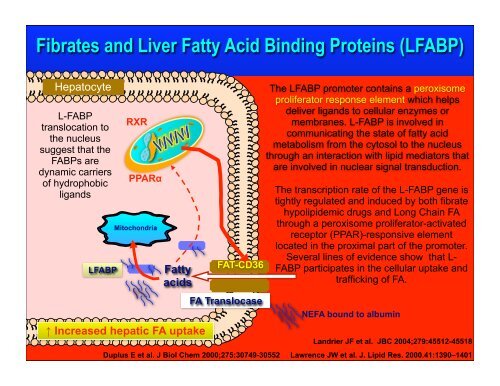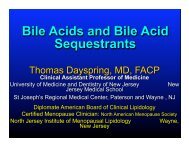Fibrate Mechanism of Action - The Center for Cholesterol Management
Fibrate Mechanism of Action - The Center for Cholesterol Management
Fibrate Mechanism of Action - The Center for Cholesterol Management
You also want an ePaper? Increase the reach of your titles
YUMPU automatically turns print PDFs into web optimized ePapers that Google loves.
<strong>Fibrate</strong>s and Liver Fatty Acid Binding Proteins (LFABP)<br />
Hepatocyte<br />
L-FABP<br />
translocation to<br />
the nucleus<br />
suggest that the<br />
FABPs are<br />
dynamic carriers<br />
<strong>of</strong> hydrophobic<br />
ligands<br />
LFABP<br />
RXR<br />
PPARα<br />
Mitochondria<br />
Fatty<br />
acids<br />
↑ Increased hepatic FA uptake<br />
FAT-CD36<br />
FA Translocase<br />
<strong>The</strong> LFABP promoter contains a peroxisome<br />
proliferator response element which helps<br />
deliver ligands to cellular enzymes or<br />
membranes. L-FABP is involved in<br />
communicating the state <strong>of</strong> fatty acid<br />
metabolism from the cytosol to the nucleus<br />
through an interaction with lipid mediators that<br />
are involved in nuclear signal transduction.<br />
<strong>The</strong> transcription rate <strong>of</strong> the L-FABP gene is<br />
tightly regulated and induced by both fibrate<br />
hypolipidemic drugs and Long Chain FA<br />
through a peroxisome proliferator-activated<br />
receptor (PPAR)-responsive element<br />
located in the proximal part <strong>of</strong> the promoter.<br />
Several lines <strong>of</strong> evidence show that L-<br />
FABP participates in the cellular uptake and<br />
trafficking <strong>of</strong> FA.<br />
NEFA bound to albumin<br />
Landrier JF et al. JBC 2004;279:45512-45518<br />
Duplus E et al. J Biol Chem 2000;275:30749-30552 Lawrence JW et al. J. Lipid Res. 2000.41:1390–1401



